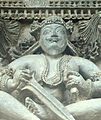Hoysala Empire facts for kids
The Hoysala Empire (Kannada: ಹೊಯ್ಸಳ) was a powerful Indian empire. It ruled over parts of southern India for more than 300 years. This was from about the year 1000 to 1346 A.D. The capital city of the empire was Belur in Karnataka.
The Hoysala Empire is best known today for its amazing buildings. Many hundreds of beautiful temples can still be seen across Karnataka. Famous examples are in the cities of Belur, Halebid, and Somnathpura. The Hoysala kings followed both Jainism and Hinduism. King Vishnuvardhana and the kings who came after him mainly believed in Vaishnavism, a branch of Hinduism.
At first, the Hoysalas were just a small group under the Chalukyas of Kalyani. But they slowly grew stronger and created their own empire in Karnataka. The time of the Hoysalas is seen as one of the greatest periods in the history of Karnataka. It is often compared to the Vijayanagara Empire. Important Hoysala kings included Vishnuvardhana, Veera Ballala II, and Veera Ballala III. The main language spoken by the Hoysala kings was Kannada. They also helped develop both Kannada and Sanskrit writing.
Contents
Important Hoysala Kings
The Hoysala Empire was led by many strong kings. They helped the empire grow and become famous. Here is a list of some of the most important rulers and when they reigned:
- Nripa Kama (1000 - 1045)
- Vinayaditya (1045 - 1098)
- Ereyanga (1098 - 1100)
- Veera Ballala I (1100 - 1108)
- Vishnuvardhana (1108 - 1152)
- Narasimha I (1152 – 1173)
- Veera Ballala II (1173 – 1220)
- Narasimha II (1220 – 1235)
- Vira Someshwara (1235 – 1253)
- Narasimha III (1253 – 1292)
- Ramanatha (1253 – 1295)
- Veera Ballala III (1292 – 1342)
Hoysala Architecture and Art
The Hoysala Empire is most famous for its unique style of temple building. These temples are known for their detailed carvings and star-shaped designs.
Famous Hoysala Temples
Many temples were built during the Hoysala period. They show the amazing skill of the artists and builders.
- The Chennakeshava Temple, Belur is a beautiful example. It was built by King Vishnuvardhana.
- The temples at Halebid are also very famous. They have incredibly detailed sculptures.
- The Chennakesava Temple, Somanathapura is another stunning temple. It is known for its intricate carvings.
These temples often feature many sculptures. They show gods, goddesses, animals, and scenes from daily life. The carvings are so detailed that they look like lace made of stone.
Unique Building Style
Hoysala temples are often built on a raised platform called a jagati. This platform allows people to walk around the temple. The temples also have a special tower called a vimana. This tower is often shaped like a star. The walls are covered with many small carvings. These carvings tell stories from Hindu myths and legends.
Culture and Language
The Hoysala kings played a big role in developing culture in Karnataka. They supported writers and artists.
Language and Literature
Kannada was the main language of the Hoysala court. Many important literary works were created in Kannada during this time. The kings also supported the ancient language of Sanskrit. This led to a rich period for both languages.
Religion in the Empire
The Hoysala rulers were open to different religions. They supported both Jainism and Hinduism. Many temples were built for both faiths. King Vishnuvardhana, who was originally a Jain, later became a follower of Vaishnavism. This shows the mix of beliefs during the empire's time.
Images for kids
-
Sala fighting the Lion or Tiger, the emblem of the Hoysala Empire at Belur, Karnataka.
See also
 In Spanish: Hoysala para niños
In Spanish: Hoysala para niños















